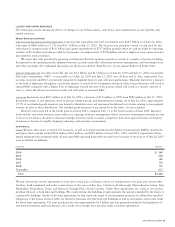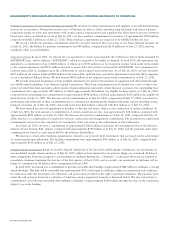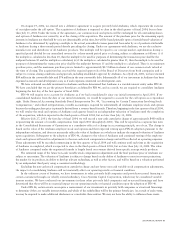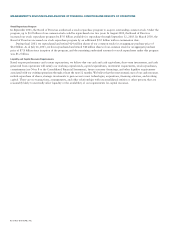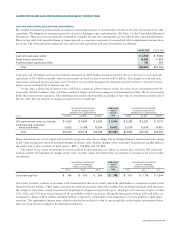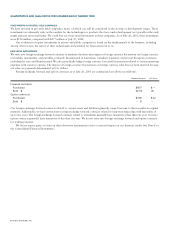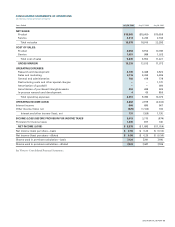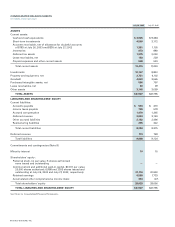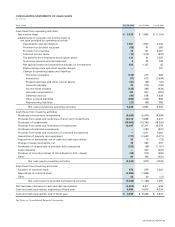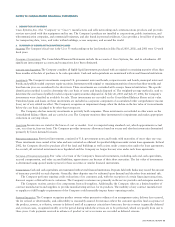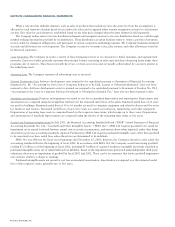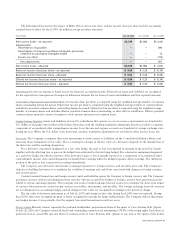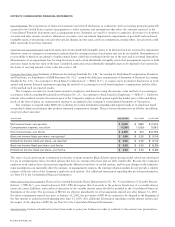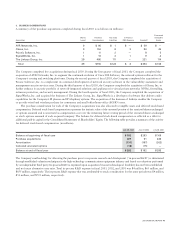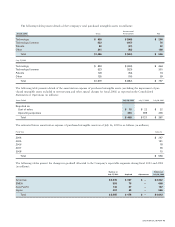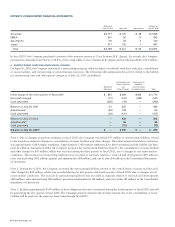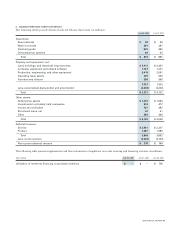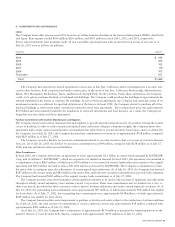Cisco 2003 Annual Report Download - page 41
Download and view the complete annual report
Please find page 41 of the 2003 Cisco annual report below. You can navigate through the pages in the report by either clicking on the pages listed below, or by using the keyword search tool below to find specific information within the annual report.
1. DESCRIPTION OF BUSINESS
Cisco Systems, Inc. (the “Company”or “Cisco”) manufactures and sells networking and communications products and provides
services associated with that equipment and its use. The Company’s products are installed at corporations, public institutions, and
telecommunication companies, and commercial businesses, and also found in personal residences. Cisco provides a broad line of products
for transporting data, voice, and video within buildings, across campuses, and around the world.
2. SUMMARY OF SIGNIFICANT ACCOUNTING POLICIES
Fiscal Year The Company’s fiscal year is the 52 or 53 weeks ending on the last Saturday in July. Fiscal 2003, 2002, and 2001 were 52-week
fiscal years.
Principles of Consolidation The Consolidated Financial Statements include the accounts of Cisco Systems, Inc. and its subsidiaries. All
significant intercompany accounts and transactions have been eliminated.
Cash and Cash Equivalents The Company considers all highly liquid investments purchased with an original or remaining maturity of less than
three months at the date of purchase to be cash equivalents. Cash and cash equivalents are maintained with several financial institutions.
Investments The Company’s investments comprise U.S. government notes and bonds; corporate notes and bonds; municipal notes and
bonds; and publicly traded corporate equity securities. Investments with original or remaining maturities of more than three months and
less than one year are considered to be short-term. These investments are custodied with a major financial institution. The specific
identification method is used to determine the cost basis of notes and bonds disposed of. The weighted-average method is used to
determine the cost basis of publicly traded corporate equity securities disposed of. At July 26, 2003 and July 27, 2002, the Company’s
investments were classified as available for sale. These investments are recorded on the Consolidated Balance Sheets at fair value.
Unrealized gains and losses on these investments are included as a separate component of accumulated other comprehensive income
(loss), net of any related tax effect. The Company recognizes an impairment charge when the decline in the fair value of its investments
below the cost basis is judged to be other-than-temporary.
The Company also has minority investments in privately held companies. These investments are included in other assets on the
Consolidated Balance Sheets and are carried at cost. The Company monitors these investments for impairment and makes appropriate
reductions in carrying values.
Inventories Inventories are stated at the lower of cost or market. Cost is computed using standard cost, which approximates actual
cost, on a first-in, first-out basis. The Company provides inventory allowances based on excess and obsolete inventories determined
primarily by future demand forecasts.
Restricted Investments Restricted investments consisted of U.S. government notes and bonds with maturities of more than one year.
These investments were carried at fair value and were restricted as collateral for specified obligations under certain lease agreements. In fiscal
2002, the Company elected to purchase all of the land and buildings as well as sites under construction under the lease agreements.
As a result, all restricted investments were liquidated and the Company no longer has any sites under such lease agreements.
Fair Value of Financial Instruments Fair value of certain of the Company’s financial instruments, including cash and cash equivalents,
accrued compensation, and other accrued liabilities, approximate cost because of their short maturities. The fair value of investments
is determined using quoted market prices for those securities or similar financial instruments.
Concentrations Cash and cash equivalents are maintained with several financial institutions. Deposits held with banks may exceed the amount
of insurance provided on such deposits. Generally, these deposits may be redeemed upon demand and therefore bear minimal risk.
The Company performs ongoing credit evaluations of its customers and, with the exception of certain financing transactions,
does not require collateral from its customers. The Company’s customers are primarily in the service provider and enterprise markets.
The Company receives certain of its components from sole suppliers. Additionally, the Company relies on a limited number of
contract manufacturers and suppliers to provide manufacturing services for its products. The inability of any contract manufacturer
or supplier to fulfill supply requirements of the Company could materially impact future operating results.
Revenue Recognition The Company recognizes product revenue when persuasive evidence of an arrangement exists, delivery has occurred,
the fee is fixed or determinable, and collectibility is reasonably assured. In instances where the customer specifies final acceptance of
the product, system, or solution, revenue is deferred until all acceptance criteria have been met. Service revenue is generally deferred
and, in most cases, recognized ratably over the period during which the services are to be performed, which is typically from one to
three years. Cash payments received in advance of product or service revenue are recorded as deferred revenue.
2003 ANNUAL REPORT 39
NOTES TO CONSOLIDATED FINANCIAL STATEMENTS


